... of apples in the world. It is estimated that there are 7,500 named varieties gown throughout the world (source: University of Illinois).
A couple hundred years ago (1800’s), it is estimated that there were 14,000 named varieties in the US (source: Brooklyn Botanic Garden). It is estimated there were 30,000 named varieties grown in the world by the 1940’s (source: Agri Benchmark). Granted, a lot of these apple varieties were for cider, but 30,000 varieties is incredible.
Unfortunately, after World War 2, this vast number of varieties began to disappear. Today, although there are about 100 varieties grown commercially in the US, only about 30 varieties of apple are commonly seen. Often less than 10 varieties, if that, are seen in a grocery store for most consumers.
Growing your own apple trees is a way to save these old varieties and flavors.
In the eastern US, apple trees are exposed to a fungal infection called Cedar-Apple Rust. This infection can kill apple trees or stunt them so much they never produce apples.
There are two solutions:
1. Grow any variety of apple you want, but you’ll need to spray your apple trees with antifungal chemicals to prevent/treat cedar-apple rust.
2. Only grow apple varieties that are immune or resistant to the infection.
Since I don’t want to spray my apples with chemicals, and our farm here in East Tennessee is literally surrounded by Eastern Red Cedar trees, our solution is to only grow certain varieties.
I’m growing 25 different varieties on our farm. They are 3-5 years old (one is 7 years old). All were selected for immunity or resistance to Cedar-Apple Rust. Here is a list of our varieties and how they handle cedar-apple rust. Individual growing conditions will vary, so your results may be different than ours.
No Cedar-Apple Rust:
Arkansas Black
Enterprise
Freedom
Jonafree
Liberty
Orleans Antique
Starkcrimson
Virginia Beauty
Whitney (crabapple)
Very minimal Cedar-Apple Rust
Blacktwig (Mammoth): dessert and cider
Mary Ried
Minimal Cedar-Apple Rust
Black Limbertwig: dessert and cider
Goldrush
Granny Smith
Joseph
Kinnairds Choice (producing fruit)
Macoun
Mild Cedar-Apple Rust
Old Fashioned Winesap: dessert and cider
Redfree
Roxbury Russet (producing fruit): dessert and cider
Stayman Winesap: dessert and cider
Virginia Winesap: dessert and cider
Yellow Delicious
Moderate Cedar-Apple Rust
Ultra Red Jonathan
Winecrisp: growing very well despite infection
Wild-type Elderberry… big success every year when we capitalize on the harvest.
European Pears are continuing to do well with incredible growth. This is our first year with fruit. We shall see how the fare come harvest time.
Another pear tree with fruit.
Another pear tree with fruit.
Another pear tree with fruit.
Aronia berries. These small shrubs are lanky, but have been fairly productive early. It’ll be interesting to see if the plants fill out and give higher yields. Berries are way to tannic and tart for fresh eating, but would be a great addition to juice or jams. Super antioxidant.
Cold-hardy citrus! This is Flying Dragon Tifolate Orange.
A Highbush Cranberry bush. Doing pretty well. Looks like we might get fruit this year!
A few clumps of wildflowers growing between trees.
About 50% of our apple trees have fruit this year. We’ve got about 20 (?) varieties we are testing out.
Some plants just died while others right next to it are thriving. This is an Autumn Olive that is supposed to grow so well they are considered invasive by some people… well, I don’t think any of our Autumn Olives have survived. Lol.
This is a Medlar. These trees produce a fruit that ripens after picked and taste kind of like cinnamon apple sauce. We’ve not had any fruit make it to harvest yet, but the trees are ground well. Each tree has a handful of young fruit, so hopefully we’ll get to try some fruit from our trees this year.
I love Quince. But Quince don’t seem to like our farm. It appears most of our quince have fireblight. Not good.
This is a cherry tree I thought was lost, but it produced a new shoot above the graft, so there’s hope it’ll continue to grow well.
Apple tree still producing fruit despite some cedar-apple rust. Yellow Delicious apple.
Serviceberry. We’ve not had a lot of success with these shrubs. If the fruit actually makes it to harvest, they have a great flavor… a mix of apple, blueberry, and almonds. But the fruit often gets a fungal infection. If I sprayed, I’m sure I’d get better production, but I don’t/won’t, so we’ll see if the plant can produce better when it grows larger.
Schubert Chokecherry. Beautiful foliage. Growing very slowly, but hanging in there. Maybe we’ll get fruit one day!
My Kefir Lime tree keeps coming back. Every year I have great intentions of moving it inside, but never do. This tree is tenacious! The leaves are a fantastic flavor addition to Thai recipes.


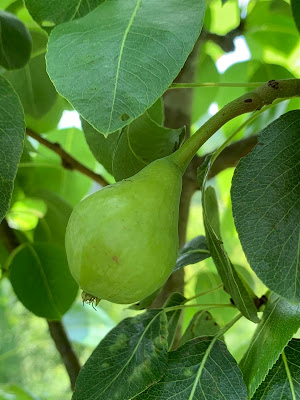








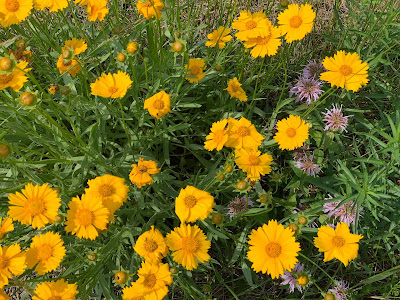
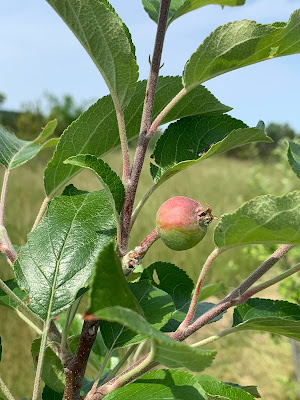




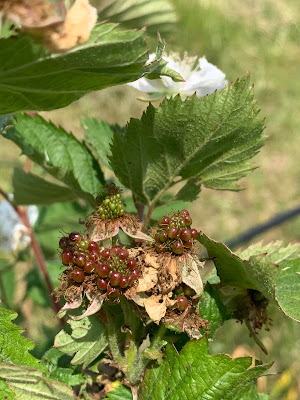



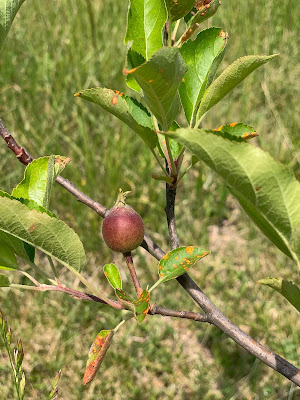



No comments:
Post a Comment